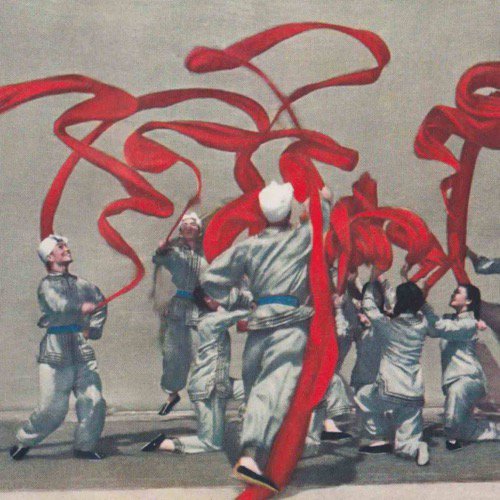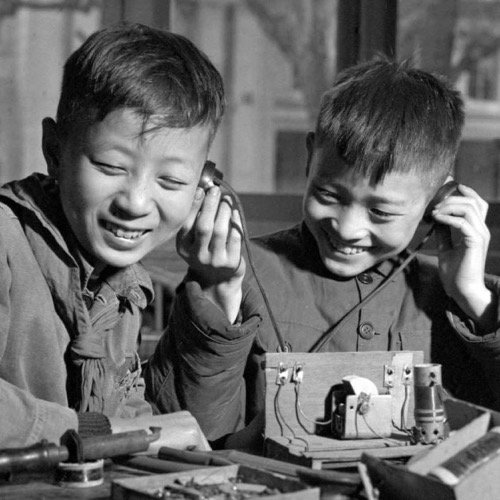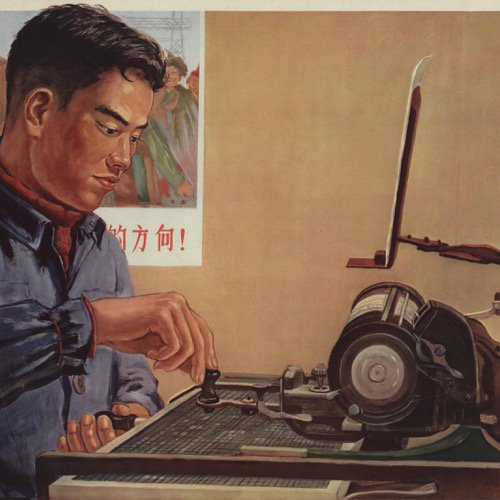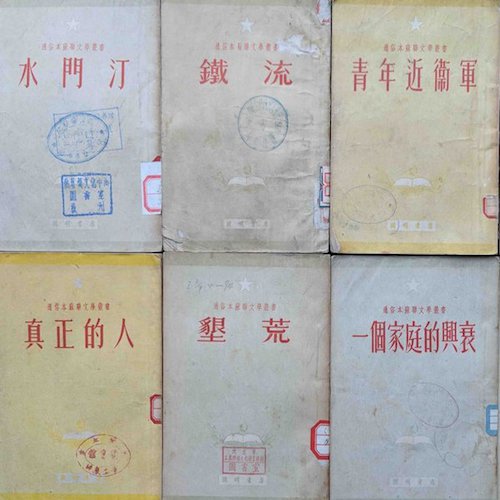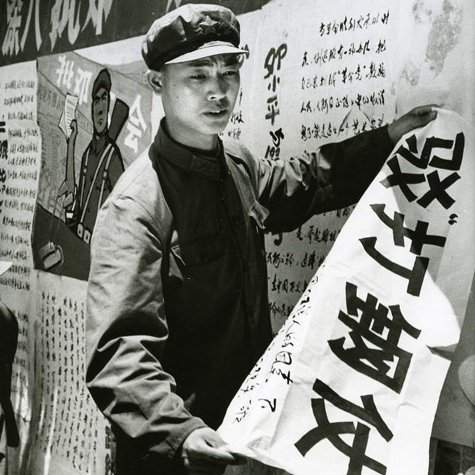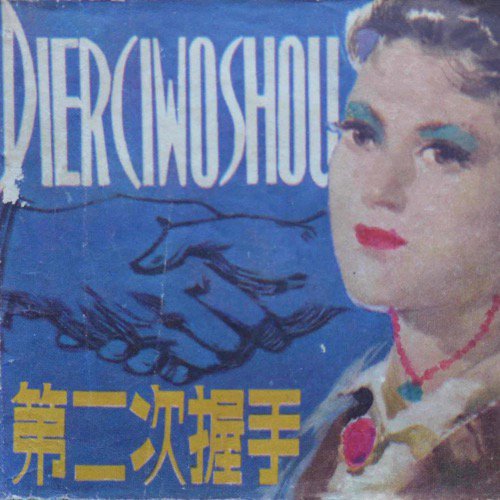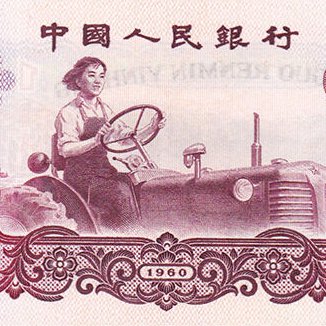Laurence Coderre, New York University
Summary
By virtue of their unique technical specifications and cultural valences, recorded audio formats bring issues of science and technology, industrial organization, artistic and cultural production, and media interplay to the fore. This biography examines the flexi-disc or flexi and its emergence in the PRC after 1968. It pays particular attention to the ways in which the Chinese flexi was deployed in a manner at odds with global trends: rather than be tied to subscription magazines, the Chinese flexi was the purview of local stations broadcasting over loudspeaker.What’s in a Format?
Most of the sound we hear in this day and age is digital, that is, it is stored and circulated in the form of 1s and 0s. The MP3 is unquestionably the dominant audio format of our time, and with music now so readily available online and on our various electronic devices, analog technologies, which store sound mechanically or magnetically, have become something of a curiosity. The vinyl record, for example, once a format of mass appeal, has increasingly become the domain of audiophiles, hipsters, and collectors. Even as such niche markets orient themselves around a basic analog/digital divide, we should be mindful of differences within these two broad, overarching categories. Each format has slightly different technical advantages, limitations, and cultural meanings. Each format, in other words, has a history. What is commonly known in English as a flexi-disc or flexi and a bomo changpian 薄膜唱片 in Chinese is a case in point and the focus of this object biography.
The Basics
As the name flexi suggests, this particular format’s most salient characteristic is the flexibility of its constituent material, but the precise significance of that flexibility must be understood in the larger context of other mechanical sound-storage technologies, like the phonographic cylinder, the gramophone record, the LP, etc. All of these technologies and formats, including the flexi, operate according to the same basic principles: Sound is stored in the form of grooves inscribed on a material substrate; when a needle is made to move through these grooves, its movements are registered as amplified vibrations or, in the case of turntables, as electromagnetic pulses. The finer the grooves, the more exact the needle’s movements and their measurement, the better the recording’s 'fidelity.' As a result, the history of recorded sound is very much a history of material substrates, including metal foil, wax, shellac, and vinyl. Most flexis are thin sheets of pliable PVC (polyvinyl chloride) plastic. This material is chemically similar to the PVC in standard vinyl records, but it has the marked advantage of being more lightweight and malleable. It is significantly cheaper to manufacture as well. That the flexi did not come to eclipse the vinyl record outright is a function of the flexi’s comparatively coarser grooves and, therefore, of its poorer sound quality. Flexi-discs were cheaper to make, but not nearly as pleasant to listen to. It didn’t help that flexis could also store far less sound than standard vinyl—coarser grooves take up more room on the surface of a disc. A seven-inch flexi, played at 331/3 rpm (rotations per minute), generally only lasts about six minutes per side.
The Flexi Around the World
Given the relative strengths and weaknesses of the format, in most places, flexis became a popular choice not for releasing music albums, but rather, for supplementing popular publications and advertising. Unlike standard vinyl records, flexis could be mailed without running the risk of major breakage, adding a new wrinkle to the subscription-magazine model. National Geographic, for one, claimed the inclusion of a flexi of Winston Churchill’s funeral in the August 1965 issue marking the former PM’s death as a 'publishing milestone.' 'The 4,650,000 records distributed with this issue of GEOGRAPHIC stand as a technical triumph in preserving high-quality sound on durable vinyl flexible enough to bind into the magazine. The record adds a rich new medium to color photography and the written word for portraying life, scenery, and the sounds of the world.'1 Although released by a Decca subsidiary, the record was actually manufactured by the American company Eva-Tone, the biggest producer of flexi-discs worldwide. (Eva-Tone had perfected and patented its 'Soundsheet' production process in 1962).2 Literally stapled into the magazine as though it were an extra page (198A), the flexi had to be ripped out along a pre-perforated line in order to be played. [See ⧉source: NatGeo]

For all its claims of breaking new ground, National Geographic was not alone in availing itself of the multimedia potential afforded periodicals by the flexi-disc. Indeed, it was not even the first. In late 1959, three new Japanese publications, KODAMA コダマ, AAA トリプルエー, and Asahi Sonorama 朝日ソノラマ, incorporated so-called sono shīto ソノシートas part of their business model. (These 'talking magazines' appear to have been promoted as, among other things, an alternative to braille for the blind).3 The first two magazines bound flexis into each issue, much like National Geographic would do nearly six years later, which the would-be listener had to physically remove before they could be used on a turntable. Asahi Sonorama, on the other hand, took the combination of magazine and flexi a step further: every issue sported a hole at the center of each page, allowing the publication to be placed directly on a record player without any changes to its binding [see ⧉source: Sonorama]. Printed text and image were overladen with embossed grooves for audio playback, and page and record merged completely. The Soviet Union also developed playable periodicals of this kind: the official music publisher Melodiia Мелодия began a magazine with flexis—gibkie plastinki гибкие пластинки in Russian—in 1964 titled Krugozor Кругозор (literally 'outlook'). A children’s magazine, Kolobok Колобок (named for a Slavic fairy tale character, lit., 'little round bun'), followed in 1968 [See ⧉source: Krugozor, also depicted to the left]. Clandestine flexis from the Soviet Union—so-called 'rock on the bones' (rok na kostiakh рок на костях) bootlegs made by young music lovers out of discarded X-rays—are now objects of fascination, but importantly, for our purposes, Krugozor and Kolobok are a testament to an abiding connection between the flexi and subscription print publications on both sides of the iron curtain.4
Flexis in the PRC
Given all of this, one might expect the PRC flexi to be similarly enmeshed with the Chinese publishing industry. What we find, however, is a very different story. China Records (Zhongguo changpian 中国唱片)—more on this monopoly in a moment—began experimenting with flexi-discs relatively late, only mass producing them in earnest in 1968, and unlike the examples given above, Chinese flexis were seldom used as magazine inserts. The two discs included in the April 1971 issue of People’s Pictorial (Renmin huabao 人民画报), a publication that targeted a foreign audience in addition to elite Chinese circles, are a notable exception [see ⧉source: Renmin huabao]. Private record players were so exceedingly rare during the Mao era that circulating flexis in this manner would have made very little sense as a matter of course domestically. What good is a record if it can’t be played? To the extent that Chinese flexi-disc production was linked to another industry, then, it was not magazines but rather broadcasting. Flexis were largely intended to be played by broadcast stations (guangbo zhan 广播站) over a network of wired loudspeakers that permeated both urban and rural spaces.5 In this context, the flexi actually overtook the vinyl record as the preeminent format for the domestic Chinese consumption of recorded sound, completely separate and apart from the periodical press. (Vinyl remained the dominant format for export).
Record production in the PRC during the Mao era was an entirely centralized affair controlled by the China Record Group (Zhongguo changpian she 中国唱片社), known since 1985 as the China Record Corporation (Zhongguo changpian zong gongsi 中国唱片总公司). This entity traces its roots back to the Great China Record Factory (Da zhonghua changpianchang 大中华唱片厂) of Republican Shanghai. After Shanghai was 'liberated' by the Communists in May 1949, Great China came under the control of the new municipal government and quickly released seven records of revolutionary songs for radio stations to play on air. The Great China Record Factory was then initially renamed the People’s Record Factory (Renmin changpianchang 人民唱片厂) and placed under the auspices of the Central Broadcasting Administration (Zhongyang guangbo shiye ju 中央广播事业局). After a series of mergers and short-lived record labels in the early 1950s, all PRC record production was brought under the Shanghai People’s Records facility, now dubbed the China Record Factory (Zhongguo changpianchang 中国唱片厂), and the China Records label in 1955. The overarching China Record Group was officially established in 1958, with its headquarters in Shanghai and eventual subsidiaries in Beijing, Chengdu, and Guangzhou [see ⧉source: China Records Group logo].6
In light of the centralization of flexi production and use in the PRC, it should come as no great surprise that the contents of the flexis released by China Records from 1968 onward reflect the shifting political priorities of the Communist regime. The initial turn to flexis coincided with the early years of the Great Proletarian Cultural Revolution (wuchanjieji wenhua da geming 无产阶级文化大革命), which is classically dated from 1966 to 1976. Although typically regarded as something of a cultural desert—a period when violence, chaos, and extreme censorship put a stop to nearly all forms of cultural production—it is important not to overstate the extent to which creativity was called to a halt. The number of records deemed politically acceptable was, in fact, exceptionally small in the late 1960s, and factory unrest did indeed disrupt production for a not inconsiderable period of time.7 However, in the record industry as elsewhere, this situation began to change slightly in the early 1970s, especially after 1972.
Picking Medicinals
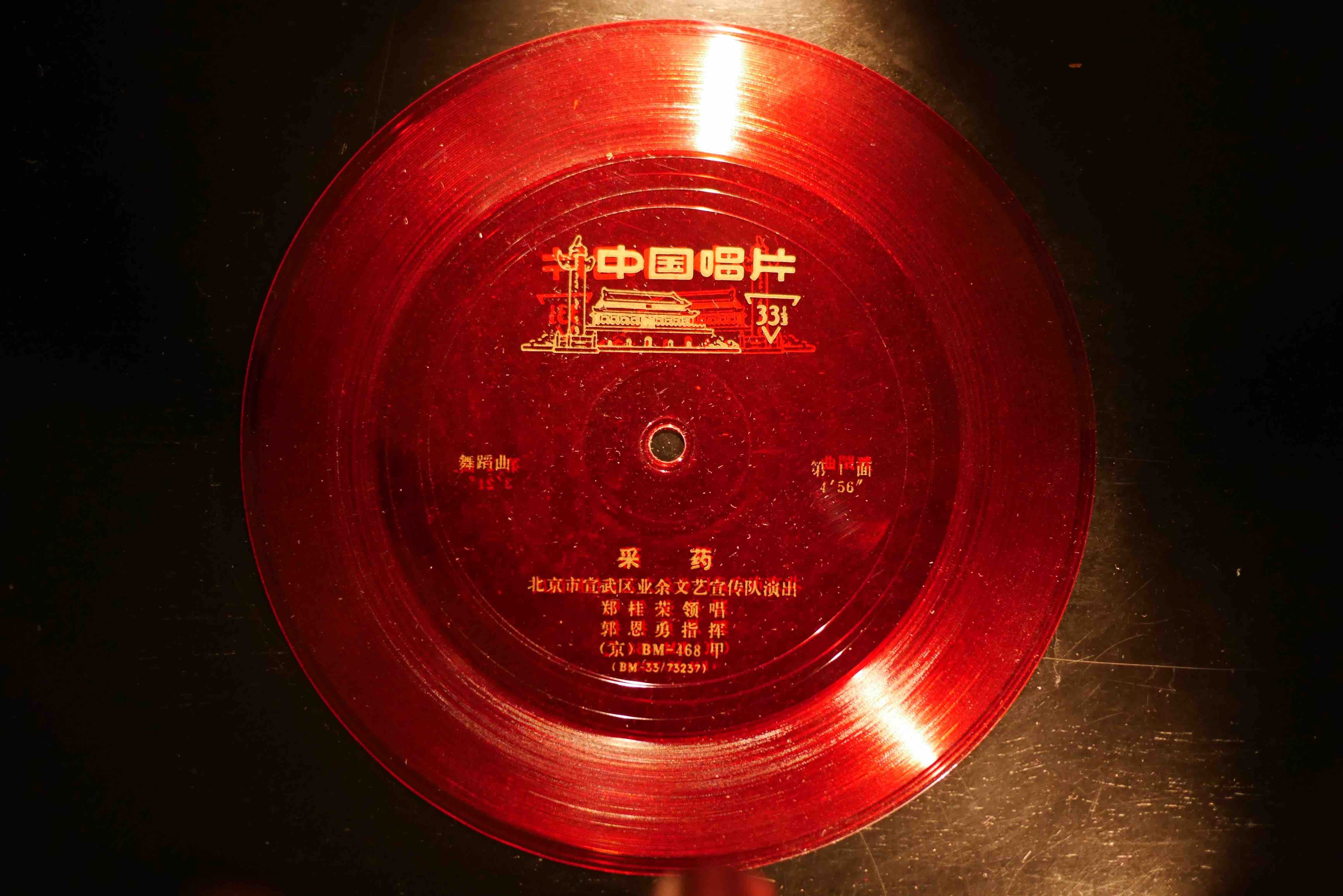
Picking Medicinals (Cai yao 采药), pressed in China Records’ Beijing factory and released in 1973, is a testament to this modest expansion of creative possibilities [see ⧉source: look at Picking Medicinals flexi-disc, including the image depicted to the right and ⧉source: listen to Picking Medicinals]. The record comprises the musical accompaniment for a short dance piece (wudao qu 舞蹈曲), which, according to the accompanying booklet, depicts a group of women collecting medicinal herbs on a mountainside [see ⧉source: Picking Medicinals accompanying booklet]. After a lengthy instrumental opening, a female chorus, under the direction of one Zheng Guirong 郑桂荣, sings two jaunty verses about happily picking herbs for the revolution. Their reverie is followed by a slower, solo meditation on the value of serving the people. The chorus picks up this second theme before reprising another verse, at which point the piece draws to a close.
Little is known about the choreography or style of the dance beyond its use of baskets as props, although we do know that it was performed as part of Beijing’s 1973 May Day celebrations [see ⧉source: Guangming Daily sketch].8 The title and focus on female performers do suggest a certain affinity with the so-called 'tea-picking' dances (cai cha 采茶) of the South. This particular recording is credited to the amateur propaganda arts troupe of Beijing’s Xuanwu district (Beijingshi Xuanwuqu yeyu xuanchuandui 北京市宣武区业余宣传队), conducted by Guo Enyong 郭恩勇. The use of 'amateur'—that is, non-professional—performers is consistent with the politics of the late-Mao era wherein training and expertise of all kinds were suspected of bourgeois taint. In the case of Picking Medicinals, the piece’s lyrics are also said to have had their origins in the proletariat, specifically, in the working men and women of Caishikou Pharmacy, also in Beijing’s Xuanwu district (Beijingshi Xuanwuqu Caishikou yiyao shangdian 北京市宣武区菜市口医药商店). (The music, on the other hand, is credited to a Yang Chunhua 杨春华, who likely had some formal education in composition). Picking Medicinals is therefore implicitly inspired by real life and, by extension, everyday expressions of revolutionary fervor.
Much more could be said about the contents of this flexi from a musical standpoint; it might be interesting to consider the relationship between the soloist and the choir as a function of the ideological relationship between the individual and the masses in the Maoist performing arts, for example. But in the context of this brief essay, I want to end by returning to the most likely circumstances in which this flexi-disc was played and heard at the time of its release. Again, given the rarity of private record players in the 1970s, themselves typically used to listen to contraband rather than official fare, playing Picking Medicinals was, in all probability, the purview of local broadcast stations. It follows, therefore, that individuals were primarily exposed to this work via loudspeakers—over which they had no control—on the street, in the field, in the factory, and perhaps even in the home. Based on the limited press coverage of the dance piece, it does not appear to have been much of a hit and would likely have been aired relatively infrequently. Even so, one can safely assume that many more people heard the music of Picking Medicinals than saw the choreographed steps it was ostensibly meant to accompany. (The flexi, moreover, comes with lyrics and music in cipher notation but no choreographic instructions, meaning that although an ambitious propaganda troupe could reproduce the sounds heard on the record, it lacked the tools to similarly reproduce the original May Day dance). As was the case with cinema, which was often consumed aurally rather than visually,9 Picking Medicinals became primarily a work of sound—arguably, of intrusive sound. Whereas flexis outside China were often used to supplement the visual as sonic add-ons to magazines, this flexi most likely helped turn an audiovisual performance into an exclusively aural experience. In this subtractive rather than additive gambit, we see the unique history of the Mao-era flexi-disc in miniature.
Footnotes
‘The Sound of Living History‘, National Geographic Magazine, (Aug. 1965), 198. National Geographic Virtual Library (http://tinyurl.galegroup.com/tinyurl/9wTED6).
Trademarked as 'Soundsheets' in the US, Eva-Tone also licensed the format abroad, to Lyntone in the UK, for example.
Miyata Shimpachiro, 'The Talking Magazine‘, Japan Quarterly vol. 7, no. 1 (1960): 111.
For additional information on flexis in these countries, see Jay Balfour, 'Bend But Don’t Break: The Resilience of the Flexi Disc' Vinyl Me, Please, 17 May 2016, (http://www.vinylmeplease.com/magazine/bend-but-dont-break-the-resilience-of-the-flexi-disc/); Phil Strongman, 'Forgotten Audio Formats: The Flexi Disc' Ars Technica, 15 April 2017 (https://arstechnica.com/gadgets/2017/04/forgotten-audio-formats-flexi-disc/); Oliver Wang, 'The Wacky, Wiggly, Razor-Thin World of the Flexi Disc', Cuepoint, 26 March 2015, (https://medium.com/cuepoint/the-wacky-wiggly-razor-thin-world-of-the-flexi-disc-8d9463bce7a2).
Indeed, the loudspeaker was so central to the way records were consumed in China that loudspeaker specifications appear to have informed aesthetic decisions in the recording studio. Andrew F. Jones, 'Quotation Songs: Portable Media and the Maoist Pop Song', in Mao’s Little Red Book: A Global History, edited by Alexander C. Cook (Cambridge: Cambridge University Press, 2014), 55.
This history is concisely outlined in Andreas Steen, 'Propaganda on Shellac, Vinyl and Plastic: The Politics of Record Production During the Cultural Revolution in China (1966-76)', Journal of Contemporary Chinese Art vol. 4, no. 2-3 (2017): 221-41.
For the stages and mechanisms of censorship as well as factory disruptions during this period, see Steen, 'Propaganda on Shellac, Vinyl and Plastic'.
Chu Lan 初澜, 'New Gains in Dance Composition' (Wudao chuangzuo de xin shouhuo 舞蹈创作的新收获 ), People’s Daily (Renmin ribao 人民日报), 10 June 1973; Dong Yi 冬一, 'Amateur Performing Arts Bear New Fruit' (Yeyu wenyi kai xin hua 业余文艺开新花). Guangming Daily (Guangming ribao 光明日报), 21 June 1973.
Nicole Huang, 'Listening to Films: Politics of the Auditory in 1970s China', Journal of Chinese Cinemas vol. 7, no. 3 (2013): 187-206.
Sources
- ⧉ IMAGE
- 文 TEXT
- ▸ VIDEO
- ♪ AUDIO
- ⧉Image Flexi-Disc: NatGeo
- ⧉Image Flexi-Disc: Sonorama
- ⧉Image Flexi-Disc: Krugozor (Кругозор)
- ⧉Image Flexi-Disc: Renmin Huabao (人民画报)
- ⧉Image Flexi-Disc: China Records Group (中国唱片) Logo
- ⧉Image Flexi-Disc: Picking Medicinals (Visual)
- ♪Audio Flexi-Disc: Picking Medicinals (Audio)
- ▤Pdf Flexi-Disc: Picking Medicinals Accompanying Booklet
- ⧉Image Flexi-Disc: Guangming Daily (光明日报) Sketch
Timeline
Further Reading
Jones, Andrew F. 'Quotation Songs: Portable Media and the Maoist Pop Song'. In Mao’s Little Red Book: A Global History, edited by Alexander C. Cook. Cambridge: Cambridge University Press, 2014: 43–60.
Liu, Alan P.L. 'Mass Media in the Cultural Revolution'. Current Scene vol. 7, no. 8 (1969): 1–8.
Mittler, Barbara. '"Eight Stage Works for 800 Million People": The Great Proletarian Cultural Revolution in Music—A View From Revolutionary Opera'. The Opera Quarterly vol. 26, no. 2-3 (2010): 377–401.
Steen, Andreas. 'Propaganda on Shellac, Vinyl and Plastic: The Politics of Record Production During the Cultural Revolution in China (1966-76)'. Journal of Contemporary Chinese Art vol. 4, no. 2-3 (2017): 221–41.
The Internet Museum of Flexi/Cardboard/Oddity Records (https://wfmu.org/MACrec/index.html).
X-Ray Audio project (https://www.x-rayaudio.com).
